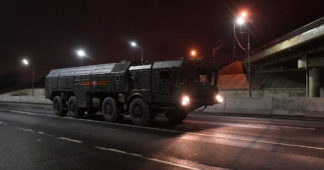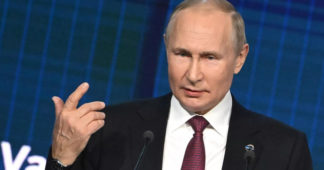UK Plans to Build New Missiles to Target Russia Linked to Pentagon’s Mad Conventional Strike Scheme
Jul 26, 2024
Sources told UK media this week that Britain has partnered up with Germany to develop and deploy a new intermediate-range missile designed to target Russia’s nuclear arsenal. Veteran Russian military observer Alexei Leonkov says the plan is inextricably linked to the Pentagon’s highly dangerous Conventional Prompt Strike (CPS) initiative.
UK Defense Secretary John Healey spoke to his German counterpart in Berlin on Wednesday about a plan to jointly develop a new strategic missile with a 3,200 km range, The Times reported on Thursday, citing sources said to be familiar with the idea.
Once developed and fielded, the new missiles would be deployed in Germany, according to the publication, replacing the American ground-based long-range fires that Washington recently announced would be stationed in the Central European country beginning in 2026.
Both the American missiles and the proposed new British-German missile would have been prohibited under the 1988 Intermediate-Range Nuclear Forces (INF) Treaty, which banned the development, production and deployment of ground-based missiles in the 500-5,500 km range. Washington violated the treaty for years, according to Moscow, and unilaterally scrapped the agreement in 2019 and immediately began testing of new long-range weapons after falsely accusing Russia of possessing a ground-based missile system with a range beyond 500 km.
One of the Times’ sources said the US weapons expected to deploy in Europe in two years’ time are meant to “bridge” a gap in European NATO allies’ own capabilities. The source did not clarify what motivated the US to ask its allies to create an entirely new missile instead buying or agreeing to permanently field existing American ones.
A joint declaration from Healey’s talks with his German counterpart, Boris Pistorius, mentioned a commitment to “undertake a long-term, comprehensive cooperation in the field of long-range capabilities” to provide “deep precision strike” potential. The details are reportedly still being worked out, with no additional information made available, besides the new missile’s expected role as a conventional fire designed to destroy enemy tactical nuclear delivery systems.
The Storm Shadow is currently the furthest-reaching conventional missile in Britain’s arsenal. It has a range of about 240 km, and has been deployed extensively by Ukraine in the NATO-Russia proxy war. The Taurus KEPD 350 is Germany’s longest-range missile system, and has a range of up to 500 km. Berlin has refused to send the air-launched weapon to Ukraine, expressing concerns that doing so would make Germany a “party to the war” because German troops would be on the ground training Ukrainians to use the missiles.
A British Defense Ministry spokesperson told The Times that the deepening UK-German defense relationship is currently “in early stages” and that work on “any new programs” has “not yet commenced.”
Europe Joins US’s Dangerous Conventional Prompt Strike Scheme
“The deployment of these missiles, both American and British, is connected to two things,” Alexei Leonkov, editor of Russia’s Arsenal of the Fatherland military affairs and technology magazine, told Sputnik, commenting on The Times piece.
“The first is the global concept, the strategy under which NATO has been restructuring toward since 2002, which is the Conventional Prompt Strike (CPS) concept, whose essence centers around the need to destroy the nuclear potentials of an adversary like Russia or China,” Leonkov said.
Thought up by the Bush administration, CPS envisions the mass deployment of thousands of conventional long-range missiles fired simultaneously in a massive surprise attack to destroy as much of an enemy’s strategic arsenal as possible, decapitate its leadership, and destroy remaining fired nuclear missiles using missile defenses.
The primary danger of the idea stems from the concern that it will make the prospect of a ‘limited’ nuclear war seem more palatable for Pentagon planners, and hence increasing the temptation to launch aggression.
The second reason for the British-German plan to develop a new missile centers around the fact that the Americans “are running late, or perhaps have lost the technologies used to create intercontinental missiles with a range beyond that of the Minuteman-3,” Leonkov argues.
“Why do the Americans want to switch up some of their missiles for European ones? I think that most likely, the missiles they have developed may not have proven entirely successful. Hence they’ve decided to attract a European consortium led by the UK.”
On top of that, as Washington’s strategic competition with China in the Asia-Pacific heats up, the number of missiles available for deployment in Europe may be limited, Leonkov believes.
The defense observer can’t rule out that the new British-German missile project may be focused on the creation of a maneuverable hypersonic vehicle, with Britain’s BAE Systems already working on a number of projects in this direction, and cooperating with US defense companies on their hypersonic projects.
In fact, these new European weapons may be the mystery “developmental hypersonic weapons” that the White House mentioned in its press statement earlier this month when it announced the deployment of new long-range strike systems to Germany from 2026 onward, Leonkov said.
Leonkov is confident that these new missiles’ mission will be to overwhelm Russian air and missile defense capabilities, and that if they are developed and fielded, Europe will become the first priority for a Russian strategic attack.
Recalling the European NATO missile threat which faced Moscow in the 1980s, Leonkov characterized the alliance’s present plans as an attempt to give rise to a Cold War 2.0, only this time far more dangerous.
“Russia today is not in a position where it has a vast security belt in the form of the Warsaw Pact countries that it did during the Cold War. Therefore, decisions will need to be changed radically. It’s clear that it will be necessary to strengthen the country’s anti-missile and anti-aircraft defense, but also take steps so that these missiles never appear on the European continent in the first place, while there is still an opportunity to do so,” the observer stressed.
Specifically, Russia will need to make clear in its nuclear doctrine that the deployment of such missiles in Europe will pose a direct threat, and give itself the right to launch a preemptive strike to eliminate this threat, Leonkov suggested.
Under its existing nuclear doctrine, Russia reserves itself the right to use nuclear weapons only in retaliation to an enemy attack using nuclear arms or other weapons of mass destruction, or in the event of conventional aggression so severe that it puts the existence of the Russian state in jeopardy. In June, President Putin hinted that Russia might revise its nuclear doctrine in response to existing threats.
What the US needs more than anything is “a quick solution that would close the issue for a while,” Leonkov said, referring to the constraints Washington will face in deploying vast numbers of long-range strike systems both to Europe and Asia. Russia’s main goal at this stage will be to “act proactively” to respond to this new threat, the analyst concluded.
We remind our readers that publication of articles on our site does not mean that we agree with what is written. Our policy is to publish anything which we consider of interest, so as to assist our readers in forming their opinions. Sometimes we even publish articles with which we totally disagree, since we believe it is important for our readers to be informed on as wide a spectrum of views as possible.











